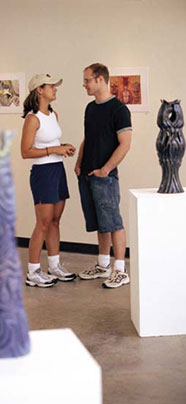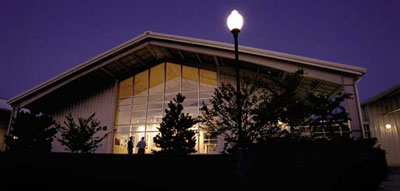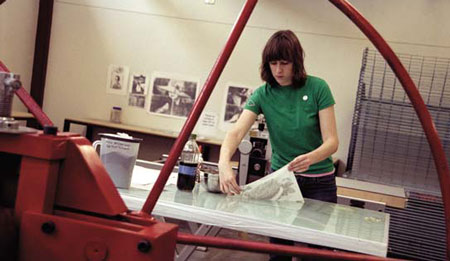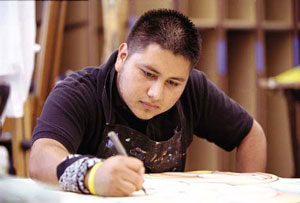| Prof analyzes presidential election | Randy Snow joins Olympic Hall | Distinguished alumni named |
 |
||
| Home Forethought Campus Buzz Feature Stories Re:Search The Score Alum News Yesteryear | ||
Jordan Yoder wasn�t about to make one of the most important decisions of his life without doing his homework. In his quest to find a college, the aspiring artist researched glass-blowing programs at 30 universities. His conclusion: UTA�s was No. 1.
 |
| Seniors Christi McDonald and Quinton Hanyan discuss Hanyan's "Soul Eclipse" exhibit in the student gallery. |
�This was my first choice,� said the 19-year-old from Cleveland, Ohio. �David Keens is a great teacher and the main reason I chose UTA. I knew I was going to get good training and a lot of glass-blowing time.�
Headed by Keens, an internationally recognized artist, the glass program is wildly popular among students. Apparently so are the other programs in the Department of Art and Art History, where enrollment has almost doubled in the past five years.
And now there�s room for even more growth.
During the summer, seven programs�glass, neon, clay, sculpture, metals, painting and printmaking�moved into state-of-the-art studios on the campus� west side. Department Chairman Andy Anderson sees the move and the renovation of existing space in the Fine Arts Building as the next steps in making his department a preferred destination.
�We want people to come to UTA because of the art department, and they are,� he said. �We have out-of-state students and international students coming here specifically for our programs. We don�t want to be just the local university, but a destination school�one that�s hard to get into.�
Room to breathe
Artists create. They paint, sculpt, throw clay, blow glass, solder metals. Space and proper equipment are key, because the creative process is frequently noisy, hot and smelly.
Cramped facilities and outdated equipment have plagued several UTA art programs. But with the opening of the 35,000-square-foot Studio Arts Center, the artists can now make as much noise and generate as much heat and fumes as necessary.
Professors and students are thrilled with their new digs. The artists in glass are particularly thankful for the air conditioning. At last they can work with melted glass without melting themselves. The old outdoor shop sometimes became so fiery that students would nearly pass out.
 |
| The new Studio Arts Center not only houses the gallery but features studios for clay, sculpture, glass, painting, printmaking and metals. |
�The Fine Arts Building was originally designed for office and classroom space,� Anderson noted. �It was first used for architecture, and they tend to sit and draw. We have more of a habit of exploding things. We were doing things that the building simply couldn�t be adapted to.�
Five years ago when Anderson became chair, he and Associate Chairman Jack Plummer sat down to evaluate the department. They and then-President Robert Witt all acknowledged big problems with the Fine Arts Building, what Anderson called a �terrible, terrible space� for some of the art programs.
�Nobody had anticipated the full glass program that we had developed, or that metals would grow so rapidly. Plus we had a greatly expanded ceramics program.� Clearly, several programs needed more�and better-designed�space for continued growth. So a dialogue began.
Cost concerns led the department to a location on the western edge of campus, outside the main corridor.
�We knew that if we built an annex within the main body of the campus, it would have to look like all of the other buildings and would be very expensive,� Anderson said. The eventual site near Maverick Stadium features an industrial-type metal building, something quite common for university art departments.
�What we�re doing are very industrial activities,� Anderson said. �We have forges and kilns over there.�
The building, originally budgeted at $3.8 million but with a final cost of $5 million, was planned so that each professor could work individually with the architect to design his or her own space. Art faculty members were so dedicated to the project that when a budget crisis loomed and all building projects went on hold, they voluntarily offered to teach more classes rather than cut offerings within the department. Their sacrifice so impressed administrators that the center went back on the construction schedule.
Even then, budget issues continued to prompt design changes. Originally seen as a large, block building, the complex became an open square with a courtyard when department leaders realized that in a block building hallways consume 40 percent of the space.
The finished product surrounds a courtyard (complete with a migrating flock of plastic pink flamingoes) that will eventually be filled with sculptures.
Just look for the neon signs
Assistant Professor Dalton Maroney, who heads the sculpture program, was eager to begin work in the new facility. He�s also relieved that the moving process is over. His studio contains a 40-cubic-foot, 6,720-pound gas kiln, one of the largest pieces of equipment to move this summer and the centerpiece of a foundry where students will create bronze sculptures.
�This new facility will accommodate our processes in a far more efficient way than the old space,� he said.
The ceramics program also benefited with the addition of three huge kilns�the most and newest of any area program�to accompany a refitted old kiln. And printmaking finally has the type of ventilation and equipment needed to expand the types of processes taught.
 |
| A talented glass artist, Adjunct Assistant Professor Don Beck began teaching a neon glass course this fall. |
Adjunct Assistant Professor Don Beck oversaw the move. Beck, a glass artist who has worked with neon for 25 years, returned to college at age 50, earning an art degree in 2001. A man of many talents, he has worked at everything from racing cars to building his own house and was the one person on campus with all the skills needed�a command of construction and materials and the ability to juggle a mind-boggling to-do list�to handle the massive relocation.
�I�ve always enjoyed building things,� he explained. Good thing, because in addition to moving gigantic kilns and 8-foot steel plates for printmaking machinery, he spent the summer welding storage racks for the painting studio, building metal countertops for the metals studio and basically making himself indispensable.
�He�s literally been the guy keeping the wheels on while he�s running alongside building the wheels,� Anderson said. �You name it, he�s done it.�
Beck�s jack-of-all-trades talents complement his artistic vision. He is an established neon glass�illuminated glass, it�s called�artist. Early in his career, he worked as a consultant to repair the green argon lighting outlining one of Dallas� most prominent skyscrapers.
�They were having problems with the lighting,� he said, �fires and things like that, but we got it all taken care of.� Beck also worked for several years as a neon artist in the world�s greatest neon showplace�Las Vegas. Now he�s looking forward to some productive time in the new glass studio.
�This facility is modeled after the one at Corning,� he said. �It�s possibly
the largest hot shop in the country. With two furnaces, we�ll always have clear
glass up, and eventually we�ll be able to run the shop 24 hours a
day.
�Neon art is really going to blown glass today. We�ll blow our
own tubes, using stripes and various colors. There are a number of techniques we
can use, and all of them can be illuminated.�
Beck has seen a big demand for his course, which is new to UTA this fall, and he believes it will only continue to grow. �Neon is becoming more and more an addition to other art forms. It�s being added to paintings, sculptures, metals and architectural work.�
The University will add seven of Beck�s neon pieces to the front of the arts center when he completes work on a series of neon icons, each representing one of the creative disciplines in the facility.
For all the artists, the structure is about creativity�and safety.
�We had big issues in the old building with ventilation and environmental concerns,� he said. �There really was no ventilation to speak of. Now, in any studio, when toxic chemicals or materials are present, the system automatically kicks on. In fact, motion sensors in the studios ramp up the ventilation systems whenever anyone walks in the room.�
 |
| Senior Breanne Trammell demonstrates a collagraph process in her printmaking class. |
The glass is full
For programs like glass and metals, ventilation is critical. Over the past 12 years, the glass program has grown into a high-demand marquee offering for the department. Associate Professor Keens� classes are always full, with waiting lists.
�Demand is so high that we could fill as many classes as we could offer,� he said. �I get calls all summer, people begging to get in classes for the fall. The bachelor of fine arts with a concentration in glass is now one of the most popular programs on campus despite its small size.
�This facility allows us to offer many more classes with our greatly increased capacity. If we can get the funds for more instructors, this program can make a great leap forward. Right now we have quite a substantial demand for a graduate program in glass. We have the only undergraduate glass program in this part of the country, and to have a graduate program would be a big step.�
Yoder, for one, would be interested in taking that step. Heartbroken that he was unable to return to UTA this fall for personal reasons, the promising Ohio student hopes to come back some day for graduate work.
�My year here was one of the best years of my life. To be honest, I impressed myself,� he said. �I feel like I�ll always have a home at UTA.�
The popularity of the glass program, not only with students but the public, is apparent at the annual glass sale. Held the third Wednesday in April between the Architecture and Fine Arts buildings, the event resembles a crowded street bazaar, attracting buyers from all over Texas. Proceeds help fund the glass program.
With the successful glass sale as a guide, metals Assistant Professor Susan Sitzes and her students may draft a similar public offering. �It�s important for students to create production pieces and learn how to price their work,� she said. �They need the experience.�
Like the other professors in the arts center, Sitzes had input into how her studio was laid out. �It took about three 18-wheelers to move all of our equipment over here. We have all kinds of stuff�drill presses, lathes, dozens of hammers, anvils, braising equipment. � It�s a bit overwhelming.�
Space problems caused Sitzes to put off teaching some metals processes in her old studio. �I was holding out on doing some of them just from a safety perspective. But here, we can do anything. Eventually, we may even try a little blacksmithing out on our back porch.
�It�s all going to be a process over time, but now we have the facilities and the possibilities.�
Seeing the light
An important part of the facility is its security system. When the creative urge strikes, artists need access to their work. �We�re a 24-hour department,� Anderson said. �Now our students will have access by card scan.�
Access to appropriate light was important to Assistant Professor Marilyn Jolly, who heads the painting program. Both of her new studios (count them, two) have full-length, north-facing windows, providing perfect light for painters.
 |
| Senior Carlos Donjuan works on a watercolor in one of two spacious painting studios in the Studio Arts Center. |
�The big difference here is that we have the proper ventilation and we have two painting studios. Having a special place for the upper-level students to work is a real plus for them. They really take ownership of their space, and that�s very important. It makes a huge difference in the level of work that students produce.�
They need the extra room this semester because enrollment in Jolly�s painting classes is maxed out.
She specializes in painting with encaustic, a wax-based paint that she mixes herself. �It�s a very tactile kind of paint,� she explained. �It sets up very quickly, and you can build it up very quickly. You can actually carve into it�do relief sculptures. And the colors are very luminous.�
The facility also includes a lounge and a student gallery run by the Student Art Association.
�The lounge is an informal place to relax,� Jolly said. �And yet, it�s a place where the students can talk seriously about their work. As they advance, art students tend to kind of �live� at the studio. This gives them a special place to go.�
Anderson calls the gallery, which faces Davis Drive, �our visual link to the community.�
 |
| Associate Professor Dalton Maroney teaches architecture senior Tiana Flynn about the proportions of the head, profiles and proper use of tools during a sculpture class. |
So what happened to the old studios in the Fine Arts Building after everyone moved out? Well, everyone did not move out. In fact, 75 percent of the Art and Art History Department remains in the building, and spaces for the remaining disciplines have undergone a complete renovation.
Programs in photography, film/video, animation/graphics and art history have new facilities and equipment now, too. Much of the vacated art space went to theater arts, music, communication and architecture.
�The move to the new complex has strengthened the entire department,� Anderson said. �The potential exists for every area to expand. We�ve seen an incredible commitment by the University to fine arts, our media programs [photography, graphics and film/video] and our art history areas. Our philosophy is to demonstrate excellence, then ask for support, and it�s worked.
�Our facilities are the absolute best. The idea that the University is making this kind of commitment to the arts has already been unbelievable for recruiting.�
Sounds like more Jordan Yoders are on the way.
— Sherry W. Neaves
| Archives
| Alumni Association |
Giving to UTA | UTA
Home Copyright © 2004 UTA Magazine. All rights reserved. |